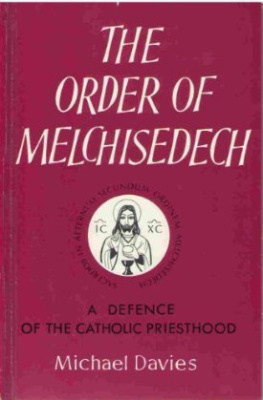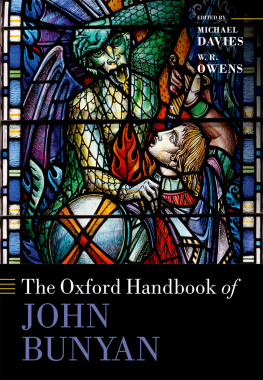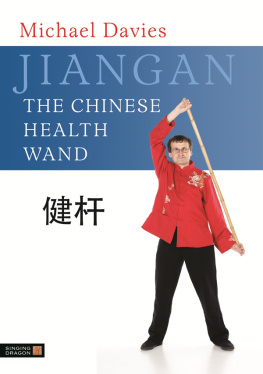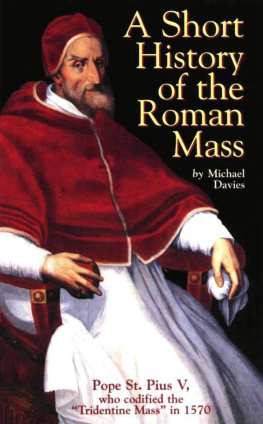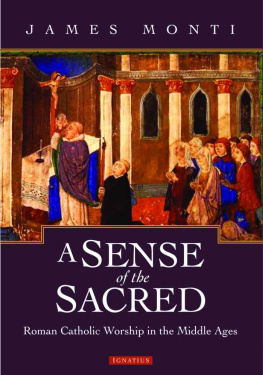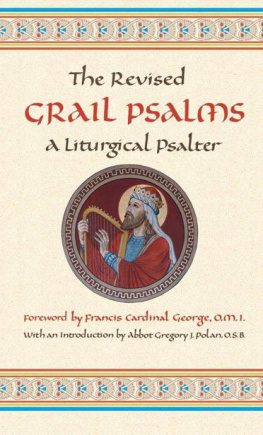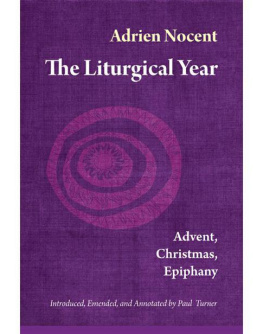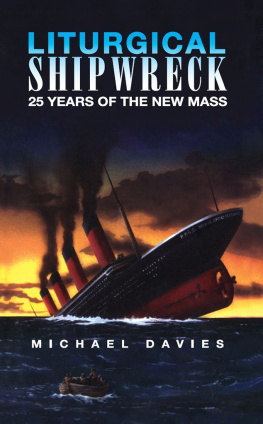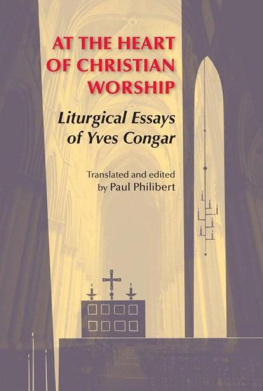Michael Davies - Liturgical Time Bombs In Vatican II: Destruction of the Faith through Changes in Catholic Worship
Here you can read online Michael Davies - Liturgical Time Bombs In Vatican II: Destruction of the Faith through Changes in Catholic Worship full text of the book (entire story) in english for free. Download pdf and epub, get meaning, cover and reviews about this ebook. year: 2015, publisher: TAN Books, genre: Religion. Description of the work, (preface) as well as reviews are available. Best literature library LitArk.com created for fans of good reading and offers a wide selection of genres:
Romance novel
Science fiction
Adventure
Detective
Science
History
Home and family
Prose
Art
Politics
Computer
Non-fiction
Religion
Business
Children
Humor
Choose a favorite category and find really read worthwhile books. Enjoy immersion in the world of imagination, feel the emotions of the characters or learn something new for yourself, make an fascinating discovery.

- Book:Liturgical Time Bombs In Vatican II: Destruction of the Faith through Changes in Catholic Worship
- Author:
- Publisher:TAN Books
- Genre:
- Year:2015
- Rating:5 / 5
- Favourites:Add to favourites
- Your mark:
- 100
- 1
- 2
- 3
- 4
- 5
Liturgical Time Bombs In Vatican II: Destruction of the Faith through Changes in Catholic Worship: summary, description and annotation
We offer to read an annotation, description, summary or preface (depends on what the author of the book "Liturgical Time Bombs In Vatican II: Destruction of the Faith through Changes in Catholic Worship" wrote himself). If you haven't found the necessary information about the book — write in the comments, we will try to find it.
Michael Davies: author's other books
Who wrote Liturgical Time Bombs In Vatican II: Destruction of the Faith through Changes in Catholic Worship? Find out the surname, the name of the author of the book and a list of all author's works by series.
Liturgical Time Bombs In Vatican II: Destruction of the Faith through Changes in Catholic Worship — read online for free the complete book (whole text) full work
Below is the text of the book, divided by pages. System saving the place of the last page read, allows you to conveniently read the book "Liturgical Time Bombs In Vatican II: Destruction of the Faith through Changes in Catholic Worship" online for free, without having to search again every time where you left off. Put a bookmark, and you can go to the page where you finished reading at any time.
Font size:
Interval:
Bookmark:
Liturgical Time Bombs in Vatican II
The Destruction of Catholic Faith Through Changes in Catholic Worship
Michael Davies
Copyright 2003 by TAN Books. This book is expanded from sections of the authors earlier works entitled Pope Johns Council and Pope Pauls New MassVolumes II and III of his trilogy entitled Liturgical Revolution.
ISBN: 978-0-89555-773-5
Cover illustration: Nuns holding urns of incense at the altar during the consecration of the new Cathedral of Our Lady of the Angels in Los Angeles, California by Cardinal Mahoney on September 2, 2002. Los Angeles Times photo by Beatrice De Gea. Photo used by arrangement with Tribune Media Services International.
The cover photo illustrates the disintegration of the Catholic liturgy which has taken place as a result of the liturgical reformsboth unauthorized and authorizedthat were inaugurated as the result of the Second Vatican Council (held from 1962-1965). Shown here is a clear violation of the immemorial Catholic traditions of liturgical rites being performed by a male clergy and male acolytes, in an enclosed sanctuary before an altar of traditional specifications, facing east, according to ancient Latin ritualswhich do not include dancing or other invented ceremonies.
TAN Books
Charlotte, North Carolina
www.TANBooks.com
2013

Archbishop Annibale Bugnini, chief architect of the New Rite of Mass which was composed after Vatican Council II (1962-1965) and imposed upon the Church in 1969.
In 1975 Pope Paul VI took action to remove Archbishop Bugnini from his powerful position as Secretary of the Congregation for Divine Worship: the Holy Father dissolved the Congregation and assigned the Archbishop to Iran. (See p. 16.) Evidence shows that the Pope did this because he believed Archbishop Bugnini to be a Freemason. (See pp. 16-18.) Archbishop Bugnini died in Teheran in 1982.
Archbishop Bugnini described the liturgical reform as a major conquest of the Catholic Church. (See pp. 58-59.) The New Rite of Mass (Novus Ordo Missae) which was the centerpiece of that reform continues to be celebrated in almost every Catholic church (of the Roman Rite) in the entire world.
This book is dedicated to the memory of
Walter L. Matt,
1915-2002, who, more than any other individual, during the disastrous decades for the Church which followed the Second Vatican Council, inspired and led Catholics in the United States, through the pages of The Remnant, to remain faithful to the traditions received from the Fathers of old, and above all, to the Traditional Latin Mass, spoken of by Fr. Frederick Faber as the most beautiful thing this side of Heaven.
I am convinced that the crisis in the Church that we are experiencing is to a large extent due to the disintegration of the liturgy.
Joseph Cardinal Ratzinger
(See page 37).
Subsequent changes were more radical than those intended by Pope John and the bishops who passed the decree on the liturgy. His sermon at the end of the first session shows that Pope John did not suspect what was being planned by the liturgical experts.
John Cardinal Heenan
(See page 25).
These time bombs were ambiguous passages inserted in the official documents by the liberal periti or expertspassages which would be interpreted in an untraditional, progressivist sense after the Council closed.
Michael Davies
(See page 23).
It would be false to identify this liturgical renewal with the reform of rites decided on by Vatican II. This reform goes back much further and goes forward far beyond the conciliar prescriptions. The liturgy is a permanent workshop.
Father Joseph Gelineau
(See page 46).
One statement we can make with certainty is that the new Ordo of the Mass that has now emerged would not have been endorsed by the majority of the Council Fathers.
Msgr. Klaus Gamber
(See page 19).
The traditional Roman rite, more than one thousand years old, has been destroyed.
Msgr. Klaus Gamber
(See page 69).
CONTENTS

Ridiculum est, et satis abominabile dedecus, ut traditiones, quas antiquitus a patribus suscepimus, infringi patiamur.
It is absurd, and a detestable shame, that we should suffer those traditions to be changed which we have received from the fathers of old.
The Decretals (Dist. xii, 5)
Cited by St. Thomas Aquinas in the
Summa Theologica, II, I, Q. 97, art. 2.
LITURGICAL TIME BOMBS IN VATICAN II
Plans for a Liturgical Revolution?
During the first session of the Second Vatican Council, in the debate on the Constitution on the Sacred Liturgy, Cardinal Alfredo Ottaviani asked: Are these Fathers planning a revolution? The Cardinal was old and partly blind. He spoke from the heart about a subject that moved him deeply:
Are we seeking to stir up wonder, or perhaps scandal among the Christian people, by introducing changes in so venerable a rite, that has been approved for so many centuries and is now so familiar? The rite of Holy Mass should not be treated as if it were a piece of cloth to be refashioned according to the whim of each generation.
So concerned was the elderly Cardinal at the revolutionary potential of the Constitution, and having no prepared text, due to his very poor sight, he exceeded the ten-minute time limit for speeches. At a signal from Cardinal Alfrink, who was presiding at the session, a technician switched off the microphone, and Cardinal Ottaviani stumbled back to his seat in humiliation. The Council Fathers clapped with glee, and the journalists to whose dictatorship Father Louis Bouyer claimed that the Council had surrendered itself were even more gleeful when they wrote their reports that night, and when they wrote their books at the end of the While we laugh, we do not think, and had they not been laughing, at least some of the bishops may have wondered whether perhaps Cardinal Ottaviani might have had a point. He did indeed.
A liturgical revolution had been planned, and the Councils Constitution on the Sacred Liturgy, Sacrosanctum Concilium (CSL), was the instrument by which it was to be achieved. Very few of the 3,000 bishops present in St. Peters would have endorsed the document had they suspected its true nature, but it would have been surprising had they done so. In his book, La Nouvelle Messe, Professor Louis Salleron remarks that far from seeing it as a means of initiating a revolution, the ordinary layman would have considered the CSL as the crowning achievement of the work of liturgical renewal that had been in progress for a hundred years.
The Liturgical Movement
Let there be no mistake, there was great need and great scope for liturgical renewal within the Roman rite, but a renewal within the correct sense of the term, using the existing liturgy to its fullest potential. This was the aim of the liturgical movement initiated by Dom Prosper Guranger and endorsed by Pope St. Pius X. It was defined by Dom Oliver Rousseau, O.S.B., as the renewal of fervour for the liturgy among the clergy and the faithful. In his study of the Liturgical Movement, Father Didier Bonneterre writes:
For St. Pius X, as for Dom Guranger, writes Father Bonneterre, the liturgy is essentially theocentric; it is for the worship of God rather than for the teaching of the faithful. Nevertheless, this great pastor underlined an important aspect of the liturgy: it is educative of the true Christian spirit. But let us stress that this function of the liturgy is only secondary.
Next pageFont size:
Interval:
Bookmark:
Similar books «Liturgical Time Bombs In Vatican II: Destruction of the Faith through Changes in Catholic Worship»
Look at similar books to Liturgical Time Bombs In Vatican II: Destruction of the Faith through Changes in Catholic Worship. We have selected literature similar in name and meaning in the hope of providing readers with more options to find new, interesting, not yet read works.
Discussion, reviews of the book Liturgical Time Bombs In Vatican II: Destruction of the Faith through Changes in Catholic Worship and just readers' own opinions. Leave your comments, write what you think about the work, its meaning or the main characters. Specify what exactly you liked and what you didn't like, and why you think so.

